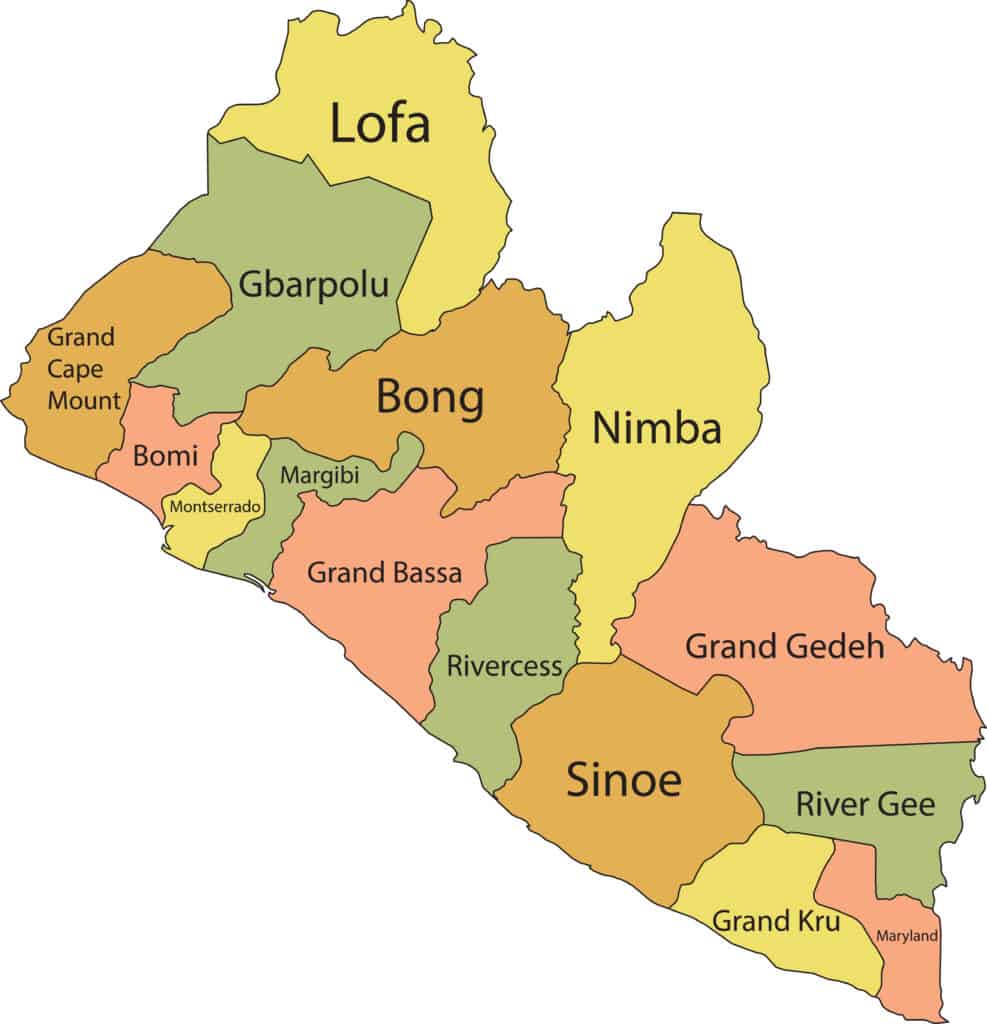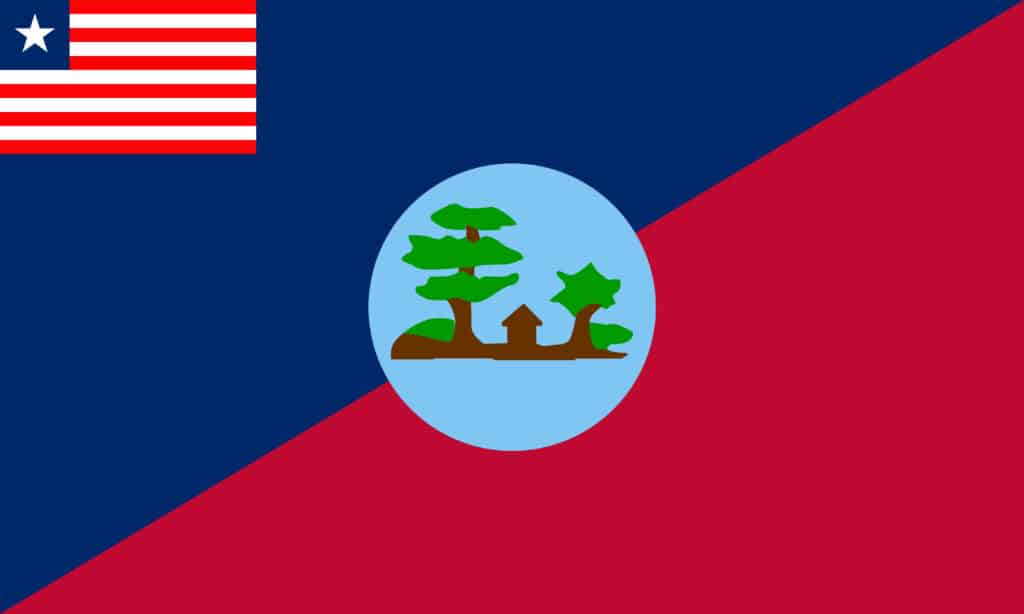Introduction
Did you know Liberia is the oldest republic in Africa? Founded in 1822, the country consisted of freed Africans who emigrated from the United States. This fact might explain why many people confuse the American flag and the flag of Liberia, as they look extremely similar. In addition, counties in Liberia each have their own flag, which were introduced as a way of unifying the country. While Liberia has experienced many political, social, and economic ups and downs since the late 1900s, their flag and their counties’ flags have maintained the same appearance, for the most part, since their introduction.

Wirestock Creators/Shutterstock.com
Founding of Liberia
Liberia was founded by the American Colonization Society in 1822. The goal of abolitionists within American Colonization Society was to return freed people of color back to their native African lands. The word Liberia derives from the Latin term liber, which means “free.” The country’s name became a reflection of the liberated status of many previously enslaved Africans, who returned to Africa.
However, 60% of those who immigrated to Liberia died by 1843, four years before the country gained independence. On July 26, 1847, Liberia gained independence because the American Colonization Society could no longer provide defense to the colony against the British and the French. Nevertheless, the American Colonization Society continued to supply financial support to the colony over the following 30 years. Remaining American support and economic control allowed for several companies to utilize natural resources within Liberia. For instance, the rubber industry thrived in Liberia.
History of Liberian Politics
Americo-Liberians, citizens of Liberia who emigrated from the United States, maintained control of economic, social, and political spheres until 1980. In April of 1980, a group of indigenous Liberians staged a coup. The leader of the coup, Samuel Doe, held power in Liberia for several years. He promoted the integration of indigenous people into government office and bureaucracy.
At first, Doe’s rule over Liberia appeared as though it would bring many benefits to the country. However, many political struggles, such as dubious election results, caused an attitude of resentment toward Doe. From 1989 to 2003, Liberia saw little peace. Two civil wars broke out in the country, and it wasn’t until 2005 that Liberia experienced a fair election.

Mimcilica/Shutterstock.com
Characteristics of Liberia
Liberia contains two groups of people: descendants of Americo-Liberians and indigenous people groups. While indigenous people groups live as tribes in the wilderness, other areas of Liberia are modernized and contain a large population of Liberian citizens. The Liberian population consists of approximately 4.85 million people. The official language is English, and both the Liberian dollar and the US dollar are used as currency in the country.
Liberian coastal climate remains warm and humid with an average yearly temperature of 80.6ºF. Central Liberia experiences a shorter rain season than that of Coastal Liberia, and night temperatures in Central Liberia are lower than on the coast.
History and Symbolism of the Flag of Liberia
The original flag of Liberia was introduced on April 9, 1827. The flag was based on the flag of the United States, as Liberia was still an American colony at the time. Its flag contained 13 red and white horizontal stripes. Red represented courage and white signified national confidence. In the upper lefthand corner, there was a blue square that contained a white cross. The blue canton symbolized the native lands of black Africans. The cross represented Christianity, as it was the religion of those who controlled the colony.
After Liberia gained independence, a new flag was introduced on August 24, 1847. Flag Day in Liberia takes place on the same day as the introduction of the new flag. The new flag of Liberia largely maintained the same appearance as the original flag. However, the cross was replaced by a singular white star. The single star reflected Liberia’s pride in being the only independent Westernized state on the African continent and the liberation of former slaves, who came to colonize Liberia. The 13 stripes adopted from the flag of the United States were replaced by only 11 stripes. The 11 stripes represented each of the 11 men that signed Liberia’s Declaration of Independence. The flag introduced in 1847 is the flag that Liberia still uses today.
Liberian County Flags
Liberian President William V.S. Tubman consistently advocated for county flags during his presidency because he believed that county flags would help to unify the country. After all, tensions between Americo-Liberians and indigenous groups within Liberia was prevalent. The flags would be a representation of the unique qualities of each county while also paying homage to the country of Liberia as a unit.
President Tubman aimed for indigenous people groups to set their sights on Liberian government, rather than their own power structures. When both indigenous people groups and Americo-Liberians focused on national government, unity would follow. Under the guise of the promotion of nationalism, President Tubman hoped his administration would be strengthened, too.

Baka Sobaka/Shutterstock.com
Creation of Liberian County Flags
Committees within each territory and county were formed to ensure that the creation of each county’s flag would be carried out. Each county’s flag included a canton that depicted the national flag of Liberia. The placement of a national flag within a canton on a colonial or territorial flag dates back to the days of the British empire. British colonial flags had cantons that contained the Britain’s national flag. The placement of the national flag on a territorial flag is significant in both Britain and Liberia because it asserts national dominance.
For instance, the canton is the part of the flag that is most visible at all times and during all wind conditions. While the other part of the flag may not be visible, the canton will be. In this way, the national flag canton will always be seen before the remainder of the territorial flag is visible. The national flag, therefore, becomes superior due to its high rate of visibility and acts as a constant reminder that each state, colony, or county is under federal law.
The first Liberian county flags date back to 1965 during Tubman’s presidency. Nine county flags were introduced by President Tubman in 1965 as a way of celebrating his 70th birthday. Over time, as more counties were created within Liberia, more county flags were introduced.
Liberian County Flag Description and Symbolism
Each county’s flag contains significant symbolism in its pattern and color-scheme. For example, the flag of Montserrado is divided diagonally from the lower lefthand corner to the upper righthand corner. The top diagonal division is blue, and the bottom diagonal division is red. In the center lies a light blue circle, containing a sketch of a small brown house between a few green and brown trees. The canton depicts the flag of Liberia. The blue and red diagonal divisions signify the juxtaposition of the county’s indigenous people and Americo-Liberian immigrants. The light blue circle with the sketch of the house and trees represents Providence Island, which was home to the first settlers of Liberia.

Baka Sobaka/Shutterstock.com
Liberian County Flag Inspiration
Inspiration for the creation of Liberian county flags has been accredited to Americo-Liberian quilt traditions. The county flags of Liberia are characterized by blocks and shapes that contain a variety of distinct color patterns. The patterns and colors exhibited by the county flags reflect the traditional quilt style brought to Liberia by immigrants from the western world. Therefore, American textile culture directly influenced the creation of the Liberian county flags. One way to look at it is that Liberian county flags continue to reflect cultural and political influences of the United States on the foundation of Liberia centuries later.
Up Next
- 10 Countries with Stars on Their Flags
- 29 Different Countries with Red, White, and Blue Flags
- The Don’t Tread on Me Flag and Phrase
The post The Flag of Liberia: History,
Meaning, and Symbolism appeared first on AZ Animals.
from Animal News, Facts, Rankings, and More! - AZ Animals https://ift.tt/0w1sPqK